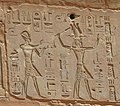Hare (hieroglyph)
| ||
| Hare in hieroglyphs | ||
|---|---|---|


The ancient Egyptian Hare hieroglyph, Gardiner sign listed no. E34 (𓃹) is a portrayal of the desert hare or Cape hare, Lepus capensis of Egypt, within the Gardiner signs for mammals. The ancients used the name of sekhat for the hare.[1]
It is an Egyptian language biliteral with the value wn,[2] (or un), often used in a hieroglyph composition block with the horizontal n.
or
| |
| |
The biliteral expresses the sound "oon", or "oonen",;[3] it is also an ideogram for the verb "to be", or "to exist",[4] (i.e. "is", "are", "was", etc.).
The famous Pharaoh Unas, (for his Pyramid texts), is named using the hare hieroglyph. It also appears in the name of Wenamun, a (possibly fictional) priest who appears in a famous history of c. 1000 BCE.
-
Detail of Hare and water-ripple quadrat (hieroglyph block)
(also shows Stool-or-mat (hieroglyph) and Throne (hieroglyph)) -
Vertical text, hare hieroglyph at beginning
-
Partially missing lunette of a stela; Finely executed in shallow, incised-bas relief
See also
Wikimedia Commons has media related to Hare (wn hieroglyph).
- Gardiner's Sign List#E. Mammals
- List of Egyptian hieroglyphs
- Pharaoh Unas - (titulary)
References
- Schumann-Antelme, and Rossini, 1998. Illustrated Hieroglyphics Handbook, Ruth Schumann-Antelme, and Stéphane Rossini. c 1998, English trans. 2002, Sterling Publishing Co. (Index, Summary lists (tables), selected uniliterals, biliterals, and triliterals.) (softcover, ISBN 1-4027-0025-3)



